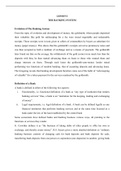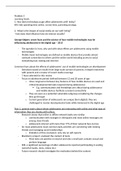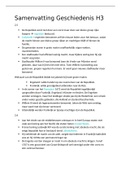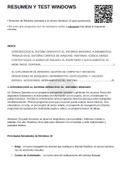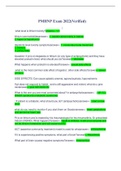LESSON I
THE BANKING SYSTEM
Evolution of The Banking System
From the topic of evolution and development of money, the goldsmith, whom people deposited
their valuables like gold for safekeeping for a fee were issued negotiable and redeemable
receipts. These receipts were in turn given to sellers of commodities by buyers as substitute for
money (paper money). This shows that the goldsmith’s receipts served as promissory notes and
was then accepted as both a medium of exchange and as a means of payment. The goldsmith
later found out that on the average, the withdrawals of the gold (coins) were much less than the
deposits with him, he then started advancing them on loans to those who wanted them and
charge interests on them. Through such loans the goldsmith-cum-money lender stated
performing two functions of modern banking- that of accepting deposits and advancing loans.
The foregoing reveals that banking development therefore came out of the habit of “safe-keeping
of valuable” for a token payment for the services rendered by the goldsmith.
Definition of a Bank
A bank is defined in either of the following two aspects:
i. Functionality, i.e. functional definition of a bank as “any type of institution that renders
banking services” thus, a bank is an “institution for the keeping, lending and exchanging
of money”.
ii. Legal requirements, i.e. legal definition of a bank. A bank can be defined legally as any
financial institution that performs banking services and at the same time licensed as a
bank under the law of the land established by the central bank
Some economists have defined banks and banking business various ways, all pointing to the
functions or services they render.
G. Crowther defines it as “the business of taking debts of other people to offer his own in
exchange, and thereby create money”. R.S. Sayers gives a more detailed definition as “ordinary
banking business consists of changing cash for bank deposits and bank deposits for cash,
transferring bank deposits from one person or corporation (one depositor) to another, giving bank
, deposits in exchange for bills of exchange, government bonds, the secured or unsecured
promises of businessmen to repay, etc.”
From the above discussion generally sums up that a bank is a legal institution which accepts
deposits from the public and in turn advances loans by creating credit. This makes it different
from other financial institution in that the later cannot create credit though they may be accepting
deposits and making advances.
Types of Banks
In general terms, about seven different types of banks can be identified in an economy. These
are:
i. Commercial Banks (retail banks) means any bank whose business includes the
acceptance of deposits which are withdrawn by cheques.
ii. Exchange banker (bankers that deal with foreign exchange and specialize in financing
foreign trade).
iii. Industrial banks (banks that provide finances to industries and underwrite the debentures
and share of industries).
iv. Agricultural Banks - banks that provide finances to farmers.
v. Corporative banks - banks organized in the principle of cooperation.
vi. Savings banks - banks that help promote small savings.
vii. Central Bank – the apex bank in a country which controls its monetary and banking
structure
Merchants banks receiving deposits on deposit account, provides finances, consultancy and
advisory services relating to corporate and investment matters, makes and manages investments
on behalf of any person or organization.(NB: A deposit account is a time deposit one that has
time frame).
Commercial Banks
Are deposit-taking institutions. They make profits by lending at higher rate of interest than
the rate they pay on deposits. A commercial bank has to decide on its desired cash ratio i.e.
THE BANKING SYSTEM
Evolution of The Banking System
From the topic of evolution and development of money, the goldsmith, whom people deposited
their valuables like gold for safekeeping for a fee were issued negotiable and redeemable
receipts. These receipts were in turn given to sellers of commodities by buyers as substitute for
money (paper money). This shows that the goldsmith’s receipts served as promissory notes and
was then accepted as both a medium of exchange and as a means of payment. The goldsmith
later found out that on the average, the withdrawals of the gold (coins) were much less than the
deposits with him, he then started advancing them on loans to those who wanted them and
charge interests on them. Through such loans the goldsmith-cum-money lender stated
performing two functions of modern banking- that of accepting deposits and advancing loans.
The foregoing reveals that banking development therefore came out of the habit of “safe-keeping
of valuable” for a token payment for the services rendered by the goldsmith.
Definition of a Bank
A bank is defined in either of the following two aspects:
i. Functionality, i.e. functional definition of a bank as “any type of institution that renders
banking services” thus, a bank is an “institution for the keeping, lending and exchanging
of money”.
ii. Legal requirements, i.e. legal definition of a bank. A bank can be defined legally as any
financial institution that performs banking services and at the same time licensed as a
bank under the law of the land established by the central bank
Some economists have defined banks and banking business various ways, all pointing to the
functions or services they render.
G. Crowther defines it as “the business of taking debts of other people to offer his own in
exchange, and thereby create money”. R.S. Sayers gives a more detailed definition as “ordinary
banking business consists of changing cash for bank deposits and bank deposits for cash,
transferring bank deposits from one person or corporation (one depositor) to another, giving bank
, deposits in exchange for bills of exchange, government bonds, the secured or unsecured
promises of businessmen to repay, etc.”
From the above discussion generally sums up that a bank is a legal institution which accepts
deposits from the public and in turn advances loans by creating credit. This makes it different
from other financial institution in that the later cannot create credit though they may be accepting
deposits and making advances.
Types of Banks
In general terms, about seven different types of banks can be identified in an economy. These
are:
i. Commercial Banks (retail banks) means any bank whose business includes the
acceptance of deposits which are withdrawn by cheques.
ii. Exchange banker (bankers that deal with foreign exchange and specialize in financing
foreign trade).
iii. Industrial banks (banks that provide finances to industries and underwrite the debentures
and share of industries).
iv. Agricultural Banks - banks that provide finances to farmers.
v. Corporative banks - banks organized in the principle of cooperation.
vi. Savings banks - banks that help promote small savings.
vii. Central Bank – the apex bank in a country which controls its monetary and banking
structure
Merchants banks receiving deposits on deposit account, provides finances, consultancy and
advisory services relating to corporate and investment matters, makes and manages investments
on behalf of any person or organization.(NB: A deposit account is a time deposit one that has
time frame).
Commercial Banks
Are deposit-taking institutions. They make profits by lending at higher rate of interest than
the rate they pay on deposits. A commercial bank has to decide on its desired cash ratio i.e.

